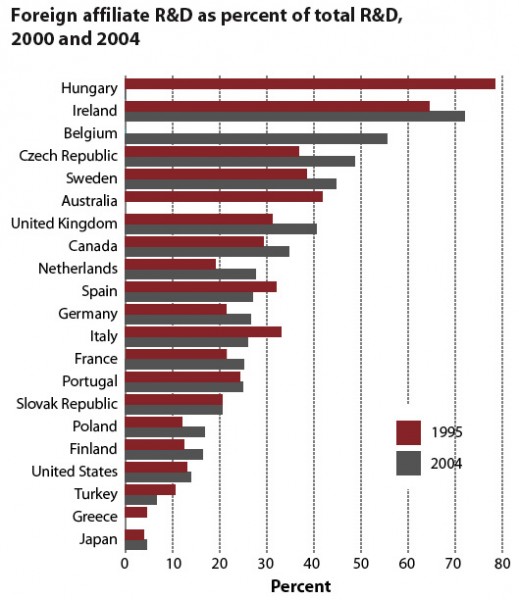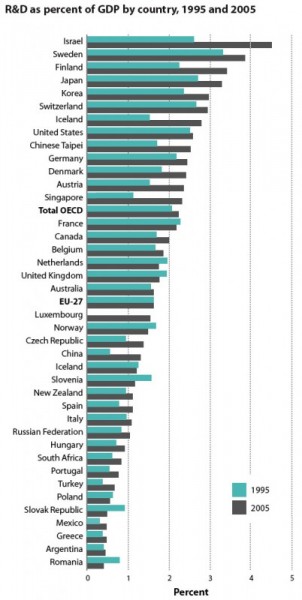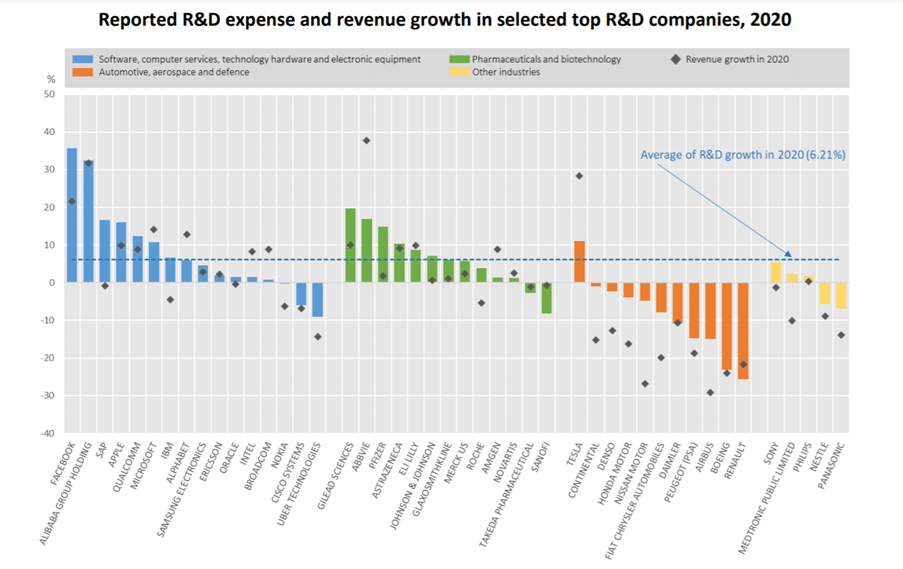Industry R&d Intensity
In 2015 this ratio which can also be denominated as RD intensity stood at 44 percent. Companies that performed or funded RD reported domestic net sales of 10 trillion in 2017.
World Trends In R D Private Investment Facts And Figures
RD intensity and Marketing intensity were calculated using the following method.

Industry r&d intensity. 2015 Millions of US. RD intensity in Germany reached 31 in 2018 up from 25 in 2006 while RD intensity in the United Kingdom rose from 16 to 17 over. This study found that firm RD intensities within industries are lognormally distributed displaying a strikingly regular pattern across industries that the industry distributions of the levels of technological competence are also lognormal and that based on the formal model of firm RD and the notion of the unobserved RD-related capabilities the distribution of firm technological competence within an industry underlies the industrys firm RD intensity.
Ranking of industrial sectors by overall sector RD intensity RD as percentage of net sales - 2016 Note. US-based Honeywell Specialty Materials for example has established a global RD position to support and speed up product development. Industry-adjusted RD Intensity and Marketing Intensity.
Sales RD Intensity and Employment of Companies that Performed or Funded RD. RD intensity by industry 2015. The record value of RD Intensity in the Top 1000 companies was 15611 for Alder Biopharmaceuticals who spent US253 million on RD while only making about US2 million in revenue.
RD Ratios Budgets contains fiscal 2018 and 2019 RD spending 2019 revenue and 2019 RD intensity ratio as well as 2018 and 2019 annual growth rates in RD spending and sales for over 2400 firms. The model shows that the cost structure of R D. OECD Science Technology and Industry Scoreboard.
OECD iLibrary RD intensity by industry 2015. It also has the second lowest producers share of total spending 55 percent. The 2019 RD spending of the automotive industry led by Toyota Honda and Ford each spending over 7 billion was essentially flat from the 2018 total as was industry revenue.
RD expenditure remained stagnant. RD intensity are global RD expenditures as a share of global value added output of industry. XXI Number 2 Summer 2009.
This indicator is commonly used at the level of. Data relate to the top 2500 companies with registered offices in the EU 590 Japan 356 the US 837 China 327 and the Rest of the World 390 ranked by total worldwide RD investment with investment in RD above 21 million. Through simple analysis of the industry RD data for the UK.
The main point is that firms in an industry do not have the same RD intensity and so industry RD intensity is composed of a distribution of RD intensity across firms. And for nonmanufacturers 34. Sales and RD intensity for companies that performed or funded RD by selected industry.
The nature of this distribution is likely to be of importance in explaining. It is possible to demonstrate the problematic nature of the interpretation of RD intensity. How COVID-19 Is Changing Pharmaceutical Research and Development.
RD in-tensity was defined as the investments made in RD and was measured as the ratio of RD expenses to total revenues for the organization Coff JOURNAL OF MANAGERIAL ISSUES Vol. OECD Science Technology and Industry Scoreboard 2017. The global RD and value added excludes several economies including China India and Mexico due to incomplete missing industry and RD data.
As a percentage of gross value added log scale. By deriving a formal model of industry R D that identifies factors influencing industry R D intensity this paper first suggests firm density defined as the inverse of average firm sales or. Australia Austria Belgium Canada Czech Republic Denmark Finland France Germany Estonia Greece Hungary Iceland Ireland Israel Italy Japan Korea Luxembourg Mexico Netherlands New Zealand Norway Poland Portugal Slovak Republic Slovenia Spain Sweden Switzerland Turkey United.
5 For all industries the R. Dollars percent and thousands of domestic employees In 2015 these five business sectors accounted for 2967 billion 83 of the 3558 billion business RD performance total that year. It is possible to demonstrate the problematic nature of the interpretation of RD intensity.
The main point is that firms in an industry do not have the same RD intensity and so industry RD intensity is composed of a distribution of RD intensity across firms. Assuming only that this process links the mean and the variance of RD intensity it implies that the same forces that influence variation in RD intensity across industries namely the industry-level. RD intensity is usually defined as the ratio of RD expenditure to an output measure usually gross value added GVA or gross output GO OECD 2015.
By deriving a formal model of industry R D that identifies factors influencing industry R D intensity this paper first suggests firm density defined as the inverse of average firm sales or simply the number of firms divided by industry sales as a measure of market structure that is appropriate in explaining industry R D intensity. The RD-intensity level has risen modestly in the United States since 2000 while China and South Korea have seen rapid increases. RD intensity is conversely declining in the mature markets as companies look to reduce costs and establish centers of excellence in areas of rapidly growing demand.
This study found that firm RD intensities within industries are lognormally distributed displaying a strikingly regular pattern across industries that the industry distributions of the levels. Additionally a large share 85 percent of its output is sold to consumers. Industry RD intensity distributions also provides a distinctive view of the determina-tion of within-industry variation in RD intensity.
RD intensity of manufacturing sectors 1995-2009. In RD intensity ratio of RD to gross domestic product GDP the United States ranked 10th in 2017. It would be interesting to find out how the relationship between the total amount spent on RD was related to how many innovation projects were supported and how effective this spend was.
Specifically the pharmaceutical manufacturing industry ranks second in terms of RD intensity at 14 percent. RD on a global scale gives access to excellent talent and the ability to do research 24. STAN Indicators.
Manufacturing industry research and development intensity between 2013 and 2015. Through simie analysis of the industry RD data for the UK. RD intensity in the EU28 area surpassed the 2 threshold for the first time rising from 198 to 203 due in large part to trends in Germany the United Kingdom and Poland.

R D Intensity By Industry Average Across Ten Countries Download Scientific Diagram

Global Trends In R D Spending Issues In Science And Technology

R D Intensity By Industry Average Across Ten Countries Download Scientific Diagram
World Trends In R D Private Investment Facts And Figures

3 Percentage Distribution Of R D Intensity By Industry Value Of Download Table

Global Trends In R D Spending Issues In Science And Technology
Global Trends In R D Spending Issues In Science And Technology

R D Research Intensity In Oecd Countries By Industry 2016 Statista

R D Intensity Per Sector Department Of Innovation Universities And Download Scientific Diagram

Pdf Firm Level R D Intensity Evidence From Indian Drugs And Pharmaceutical Industry

Research Intensity Up As Covid 19 Infects Corporate R D Spending Science Business
World Trends In R D Private Investment Facts And Figures
Posting Komentar untuk "Industry R&d Intensity"